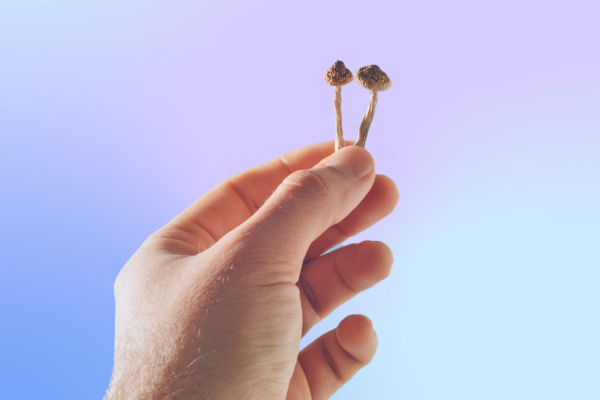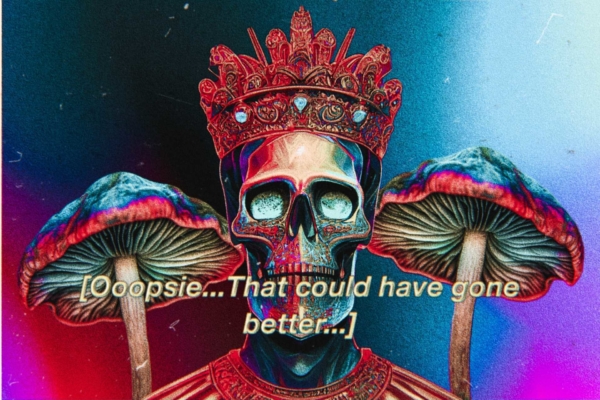
Let’s set the scene: 100,000 years ago, in the age before recorded history, our early hominid ancestors started abandoning the forests and traveling across savannahs. As they foraged in new environments, they began evolving faster, cleverer brains that eventually tripled in size. How did they accomplish this? One theory suggests that they unknowingly added psilocybin to their diet and tripped their way to high-level consciousness.
Think we’re making this up? We’re not.
The Stoned Ape Theory is a hypothesis by one of America’s most influential psychonauts, Terence McKenna. With knowledge of ecology, conservation, and shamanism, McKenna united his interests in his study of psychedelics. McKenna earned his degrees from the University of California-Berkeley’s Tussman Experimental College, and his extensive writings served as some of the West’s first exposure to the psychedelics DMT and ayahuasca.
Though he died in 2000, McKenna’s lifetime of advocating for the exploration of altered states of mind still influences modern psychonauts today. The Stoned Ape Theory is only one way in which he attempted to shift the world’s view of psychedelics.
Stoned Ape Theory 101

The Stoned Ape Theory was written into existence in McKenna’s 1992 book Food of The Gods. In its pages, he posits that one of our early ancestors –– Homo Erectus –- began eating Psilocybe cubensis as a part of their diet. The theory gets its scientific bearings from the presumed effects of psychedelic mushrooms, as cited in 1960’s/70’s studies by the likes of Roland L. Fischer.
Psilocybe cubensis frequently grows under cow poo, so the theory suggests that our hunter-gather ascendants would follow herds then stumble upon and eat the shit-coated shrooms left behind the herd as a nice light bite.
Okay, so our ancestors found some magic mushrooms in cow shit. Why should I care? Well, that unsavory snack may have changed the course of everything.
According to the Stoned Ape Theory, this simple act could have profoundly changed our ancestors’ brains. McKenna asserts that low doses of psilocybin improve visual acuity, most notably edge detection. Basically, the new addition of psilocybin in the diets of pack-hunting primates enabled them to be more exacting hunters. Then in slightly higher doses, McKenna asserts that the mushroom acts as an aphrodisiac leading to more motivation to reproduce. Mushrooms also “dissolve boundaries,” as McKenna puts it, enhancing community bonding and encouraging group sexual activities (as I’m sure most everyone’s personal experience with mushrooms corroborates).
In the documentary Fantastic Fungi, Terrence McKenna’s brother Dennis McKenna further explains the logic behind the theory:
“It was like a software to program this neurologically modern hardware,” he begins, “It’s not so simple to say that they ate psilocybin mushrooms and suddenly the brain mutated, I think it’s more complex than that, but I think it was a factor. It was like a software to program this neurologically modern hardware to think, to have cognition, to have language—because language is essentially synesthesia. Language is the association with apparently meaningless sound except that it’s associated with the complex of meaning.”
Sounds plausible, right?
Did Our Ancestors Really Eat Mushrooms?

Research has confirmed that 23 different primates, humans included, featured mushrooms in their diets over centuries of evolution. Though there are no recordings of psychedelic use in prehistory, we do know that ancient civilizations everywhere from Siberia to Central America revered psilocybin, referring to it as various translations of “food of the gods.”
To further solidify the possibility that our prehistoric ancestors were the first on the psychedelic wave, a billion-year-old fossilized fungi was uncovered by Palaeobiologist Corentin Loron.
The Stoned Ape Theory in Pop Culture
After sending the Stoned Ape Theory out into the world, McKenna didn’t get a ton of positive attention from the scientific community. Many claimed that he misinterpreted previous findings; others criticized the theory’s lack of paleoanthropological evidence.
However, the theory gained traction in pop culture. Comedian Bill Hicks performed a memorable riff on his Revelations tour, unabashedly telling his audiences that he believes that “God left certain drugs growing naturally upon our planet to help speed up and facilitate our evolution.”
More recently, Michael Pollan, author of the pro-psychedelics book How to Change Your Mind, went on the Joe Rogan Podcast and expressed doubts about the theory. Though he is a non-believer, his comments helped to recenter the theory and open up discourse between amateur psychonauts.
A Second Opinion
Then finally, in 2017, the Stoned Ape Theory was backed up by someone else from the scientific community. At the Psychedelic Science conference, mycologist Paul Stamets resurrected and repurposed McKenna’s hypothesis as a plausible answer to the long-unsolvable evolutionary mystery.
Stamets, like McKenna, believes that it is completely plausible that due to desertification, early humans made their way across savannahs and came across psilocybin “growing bodaciously out of the dung of animals.”
He confidently laid out the facts to his audience: “What is really important for you to understand is that there was a sudden doubling of the human brain 200,000 years ago. From an evolutionary point of view, that’s an extraordinary expansion. And there is no explanation for this sudden increase in the human brain.”
The reintroduction of the hypothesis was well-received by his audience of psychedelic scientists and amateur psychonauts.
The Bottom Line
While we may never unlock the big, barbed riddle of evolution, what we do know is that our relationship with psychedelics began centuries ago. Maybe cow-poop-smeared magic mushrooms are the accelerant that led to an impressive resizing of the human brain; maybe there’s a piece to this puzzle that we’re overlooking.
However, no matter what you believe, you have to give McKenna an A for effort. After all, he anticipated the Stoned Ape Theory would cause a shift, allowing voters and lawmakers to see psychedelics as beneficial to mankind. We can only hope he’s somewhere in the universe smiling at all the progress made.





